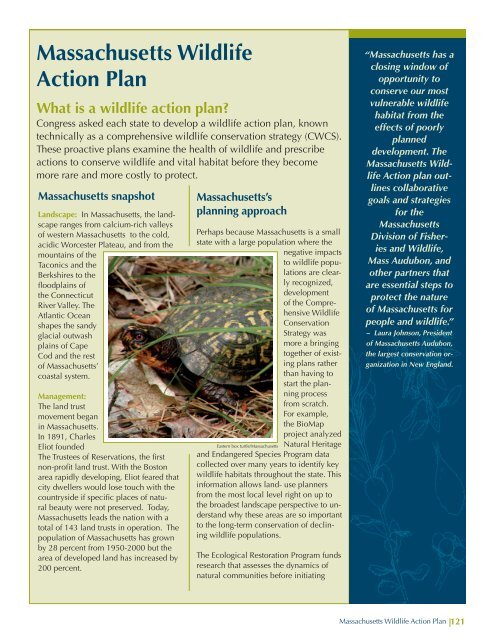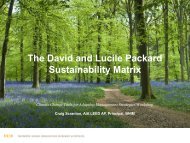State WAP Revised 8.29.06.indd - Teaming With Wildlife
State WAP Revised 8.29.06.indd - Teaming With Wildlife
State WAP Revised 8.29.06.indd - Teaming With Wildlife
You also want an ePaper? Increase the reach of your titles
YUMPU automatically turns print PDFs into web optimized ePapers that Google loves.
Massachusetts <strong>Wildlife</strong><br />
Action Plan<br />
What is a wildlife action plan<br />
Congress asked each state to develop a wildlife action plan, known<br />
technically as a comprehensive wildlife conservation strategy (CWCS).<br />
These proactive plans examine the health of wildlife and prescribe<br />
actions to conserve wildlife and vital habitat before they become<br />
more rare and more costly to protect.<br />
Massachusetts snapshot<br />
Landscape: In Massachusetts, the landscape<br />
ranges from calcium-rich valleys<br />
of western Massachusetts to the cold,<br />
acidic Worcester Plateau, and from the<br />
mountains of the<br />
Taconics and the<br />
Berkshires to the<br />
floodplains of<br />
the Connecticut<br />
River Valley. The<br />
Atlantic Ocean<br />
shapes the sandy<br />
glacial outwash<br />
plains of Cape<br />
Cod and the rest<br />
of Massachusetts’<br />
coastal system.<br />
Management:<br />
The land trust<br />
movement began<br />
in Massachusetts.<br />
In 1891, Charles<br />
Eliot founded<br />
The Trustees of Reservations, the first<br />
non-profit land trust. <strong>With</strong> the Boston<br />
area rapidly developing, Eliot feared that<br />
city dwellers would lose touch with the<br />
countryside if specific places of natural<br />
beauty were not preserved. Today,<br />
Massachusetts leads the nation with a<br />
total of 143 land trusts in operation. The<br />
population of Massachusetts has grown<br />
by 28 percent from 1950-2000 but the<br />
area of developed land has increased by<br />
200 percent.<br />
Massachusetts’s<br />
planning approach<br />
Perhaps because Massachusetts is a small<br />
state with a large population where the<br />
negative impacts<br />
to wildlife populations<br />
are clearly<br />
recognized,<br />
development<br />
of the Comprehensive<br />
<strong>Wildlife</strong><br />
Conservation<br />
Strategy was<br />
more a bringing<br />
together of existing<br />
plans rather<br />
than having to<br />
start the planning<br />
process<br />
from scratch.<br />
For example,<br />
the BioMap<br />
project analyzed<br />
Eastern box turtle/Massachusetts Natural Heritage<br />
and Endangered Species Program data<br />
collected over many years to identify key<br />
wildlife habitats throughout the state. This<br />
information allows land- use planners<br />
from the most local level right on up to<br />
the broadest landscape perspective to understand<br />
why these areas are so important<br />
to the long-term conservation of declining<br />
wildlife populations.<br />
The Ecological Restoration Program funds<br />
research that assesses the dynamics of<br />
natural communities before initiating<br />
“Massachusetts has a<br />
closing window of<br />
opportunity to<br />
conserve our most<br />
vulnerable wildlife<br />
habitat from the<br />
effects of poorly<br />
planned<br />
development. The<br />
Massachusetts <strong>Wildlife</strong><br />
Action plan outlines<br />
collaborative<br />
goals and strategies<br />
for the<br />
Massachusetts<br />
Division of Fisheries<br />
and <strong>Wildlife</strong>,<br />
Mass Audubon, and<br />
other partners that<br />
are essential steps to<br />
protect the nature<br />
of Massachusetts for<br />
people and wildlife.”<br />
– Laura Johnson, President<br />
of Massachusetts Audubon,<br />
the largest conservation organization<br />
in New England.<br />
Massachusetts <strong>Wildlife</strong> Action Plan 121




